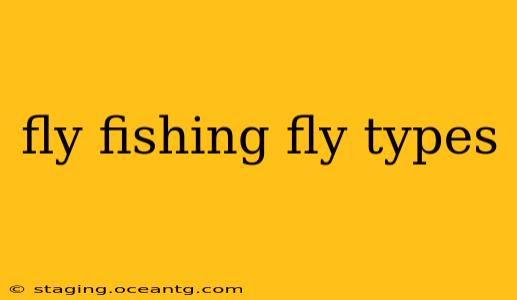Fly fishing, a sport steeped in tradition and skill, hinges on selecting the right fly. Understanding the vast array of fly types is crucial for success. This comprehensive guide explores various fly categories, their applications, and the nuances that make them effective. We'll delve into the specifics to help you choose the perfect fly for any situation.
What are the Different Types of Flies Used in Fly Fishing?
Fly fishing flies are meticulously designed to mimic insects, small fish, or other aquatic creatures that trout and other game fish feed on. The sheer variety can be daunting for beginners, but understanding the broad categories simplifies the process. We can broadly categorize flies based on their imitation:
Dry Flies: Surface Delights
Dry flies float on the water's surface, mimicking insects like mayflies, caddisflies, and terrestrial insects (ants, beetles, grasshoppers). Their buoyant nature is key; they need to sit naturally on the surface to attract a rising fish.
- Parachute Adams: A classic dry fly known for its excellent visibility and reliable floating ability. The parachute post helps keep the hook point up, reducing snags.
- Royal Wulff: A versatile and effective dry fly pattern that imitates a variety of insects. Its bright colors make it highly visible on the water.
- Elk Hair Caddis: A terrestrial pattern that imitates caddisflies and other insects that fall onto the water's surface. The elk hair creates a buoyant and lifelike profile.
Nymphs: Subsurface Delicacies
Nymphs represent the immature stage of aquatic insects. These flies are fished beneath the surface, often near the bottom or in mid-water, depending on the insect life cycle and the water's depth.
- Pheasant Tail Nymph: A simple yet highly effective nymph pattern known for its durability and versatility. It imitates a variety of aquatic insect larvae.
- Prince Nymph: A classic nymph pattern that incorporates bright colors to attract fish. It is effective in a variety of water conditions.
- Copper John: A popular nymph known for its flashy copper ribbing, which makes it highly visible in murky water.
Wet Flies: Submerged Allure
Wet flies are fished below the surface, often retrieved with a variety of techniques to create enticing movement. They can imitate nymphs, emergers, or small baitfish.
- Adams Wet Fly: A versatile wet fly that can be fished in various ways. Its simple design makes it easy to tie.
- Black Gnat: A small, dark wet fly effective for imitating a variety of small insects.
- Woolly Bugger: A highly versatile wet fly that can be adapted to imitate a range of aquatic organisms.
Streamers: Larger Targets
Streamers are larger flies designed to imitate baitfish, small frogs, or other larger prey items. They are often fished aggressively, stripping them across the current to imitate a fleeing baitfish.
- Matuka: A classic streamer pattern that imitates a variety of baitfish. Its effective design makes it a go-to for many fly fishers.
- Crazy Charlie: A popular streamer known for its erratic action and bright colors.
- Sculpin: This pattern imitates a sculpin, a small bottom-dwelling fish that is a favorite food source for many trout.
What Type of Fly Should I Use?
Choosing the right fly depends on several factors, including:
- The type of fish you're targeting: Different fish prefer different food sources.
- The time of year: Insect hatches vary throughout the year.
- The water conditions: Water clarity, current speed, and water temperature all influence fly selection.
- The location: Different water bodies contain different insect populations.
How Do I Choose the Right Fly Size?
Fly size is crucial; it should match the size of the insects or baitfish the fish are feeding on. Using the wrong size can hinder your chances of success significantly.
What Materials Are Used to Make Flies?
Fly-tying utilizes a wide range of materials, including feathers, fur, synthetic fibers, beads, and wire. The choice of materials impacts the fly's appearance, action, and durability.
What are the Best Flies for Beginners?
Beginners often find success with simple, versatile patterns like the Parachute Adams (dry fly), Pheasant Tail Nymph (nymph), and Woolly Bugger (streamer). These flies are relatively easy to tie and effective in a range of conditions.
By understanding these different fly types and their applications, you'll be well on your way to improving your fly fishing success. Remember, practice and experimentation are key to mastering the art of fly fishing.
